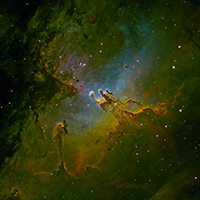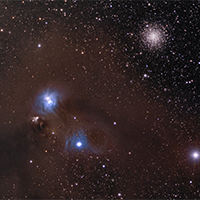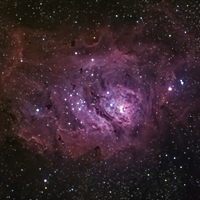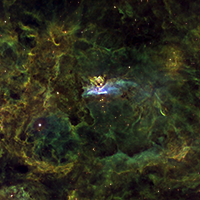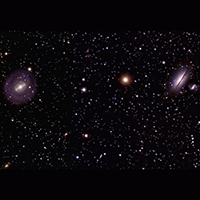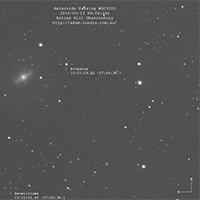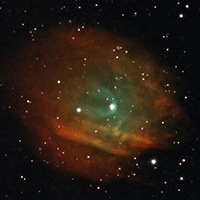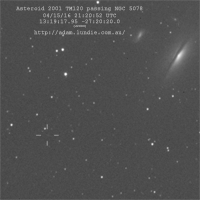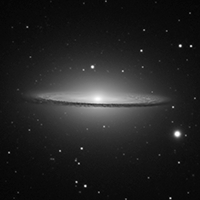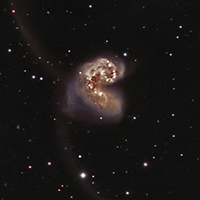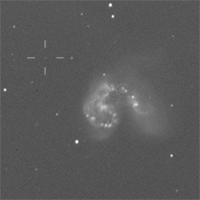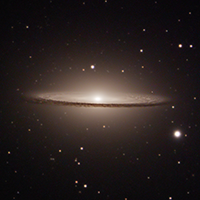A collection of astronomical photos taken by Adam Lundie at Eatons Hill Observatory.
Equipment Used:
- Telescope 1: Celestron 1100 Edge HD
- Telescope 2: Skywatcher Esprit 120ED
- Telescope 3: Skywatcher Black Diamond 80ED
- Mount: Skywatcher EQ8-Rh Pro
- Imaging Cameras: QSI 683ws-8 Monochrome, ZWO ASI290MM
- Filters: Astrodon Tru-Balance Gen 2 LRGB, Astronomik CLS-CCD, 6nm Hα, 6nm SII, 6nm OIII, ProPlanet 742nm IR-pass
- Guide Camera: Starlight Xpress Lodestar X2
- Guiding Optics: Skywatcher Evoguide 50ED, Innovations Foresight ONAG, Starlight Xpress Large Format Active Optics
- Focusers: Starlight Instruments Feather Touch + Posi Drive Motor
|
|
||
Recent Work:
05-Jul-2016
The Eagle Nebula is located 7000 light years away and is home to the famous "Pillars of Creation", shown in the centre of this image. This photograph is presented in the Hubble narrowband palette, which shows the distrubution of Hydrogen (green), Oxygen (blue), and Sulfur (red) gasses.
26-Jun-2016
Less than 500 light-years away and blocking light from more distant, background stars in the Milky Way, the densest part of the dust cloud of Caldwell 68 is about 8 light-years long. At its tip is a group of reflection nebulae cataloged as NGC 6726, 6727, 6729, and IC 4812. A characteristic blue color is produced as light from hot stars is reflected by the cosmic dust.
16-Jun-2016
Narrowband images are rarely presented as true color light. When imaging in narrowband, colors are assigned to each channel based on the specific emission lines captured. One of the most common choices is the SHO Hubble Pallet, but the choices for mixing colors are endless. Here are 9 examples of how an image of a planetary nebula may be colored.
10-Jun-2016
I was lucky enough to snag a second hand 900mm refractor at a good price. I needed a bright target to test it with. The Lagoon Nebula is a giant interstellar cloud around 4077 light years away, classified as an emission nebula and as an H II region.
07-Jun-2016
NGC 6357 is a diffuse nebula in the constellation Scorpius. The nebula contains many proto-stars shielded by dark disks of gas, and young stars wrapped in expanding gases. It is also known as the Lobster Nebula. Presented is a narrowband SHO photograph in the Hubble Space Telescope palette.
31-May-2016
This two panel mosaic shows the large galaxies NGC5101 (left) and NGC5078 (right), approximately 89 and 94 million light years distant. Galaxy IC879 is interacting with NGC5078, while galaxy IC4222 is shown in the bottom right corner. Numerous other small galaxies appear throughout the background
29-May-2016
Although Mars is at it's biggest and brightest this week, it's so small, it's a difficult subject to get any detail out of.
19-May-2016
Hispania (1915 WT) is the brightest asteroid I've ever seen. It's so bright, I had to remove it from each frame for plate solving to work. Also moving through the frame is another named asteroid: Geowilliams (1984 UL2)
10-May-2016
For my first foray into narrowband imaging, I have chosen a very dim & difficult target: planetary nebula Sh2-313, also known as Abell 35 and PK 303+40.1
19-Apr-2016
While looking through the data captured of NGC 5078, I discovered a very dim object slowly moving through the field of view. I have identified the object as main belt asteroid 2001 TM120, magnitude 15.5.
11-Apr-2016
The Southern Pinwheel Galaxy is a barred spiral galaxy approximately 15 million light-years away. It is one of the closest and brightest barred spiral galaxies in the sky.
10-Apr-2016
When it's cloudy I will go back to an image and animate the steps I took so I can watch it from start to finished. Presented in this animation are the main processing steps in sequence from my image of the Sombrero Galaxy.
06-Apr-2016
The Antennae Galaxies, also known as NGC 4038/NGC 4039, are a pair of interacting galaxies ~45 million light years away. They are currently going through a starburst phase, in which the collision of clouds of gas and dust, with entangled magnetic fields, causes rapid star formation.
05-Apr-2016
While looking through the data captured of the Antennae galaxies, I discovered a very dim object slowly moving through the field of view. I have identified the object as main belt asteroid 2000 JU23, magnitude 18.8
31-Mar-2016
The Sombrero Galaxy is an unbarred spiral galaxy 28 million light-years from Earth. The galaxy has a diameter of approximately 50,000 light-years, 30% the size of the Milky Way.
